DIY Dehumidifier
It is important to maintain a balanced relative humidity level at home. Indoor humidity levels that are not imbalanced can lead to a ton of problems. High and low humidity levels have their own set of disadvantages.
Thankfully, we have a dehumidifying process that can remove moisture from the air and balance the indoor humidity level. It is a bonus that there are several options for efficient homemade dehumidifier units for those who cannot or need not invest in a commercial or store-bought dehumidifier.
In this article, we will discuss the different DIY dehumidifiers that can be made at home to facilitate an effortless and effective dehumidifying process. With that said, let us get started!
How to Dehumidify Your Home Naturally: 6 DIY Solutions That Actually Work

It is good news that excess moisture removal from any space can be carried out even without using an electric dehumidifier. The following 6 DIY dehumidifiers are capable of removing moisture from the air effortlessly.
However, you must remember that a DIY dehumidifier cannot remove moisture as efficiently as an electric dehumidifier. A store-bought unit or a commercial dehumidifier is a recommended choice for thorough moisture extraction, especially for homes that struggle with severe moisture damage.
Let us take a look at some common household chemicals that are safe to be used as DIY dehumidifiers.
1. Rock Salt Dehumidifier
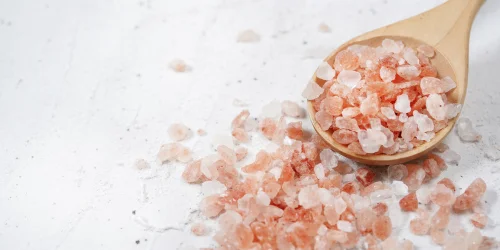
One of the best natural moisture absorbers that you can find at home is rock salt. It takes very little time and effort to make a natural dehumidifier using a bag of rock salt. Rock salt absorbs moisture from the air and its immediate surroundings and therefore it can be trusted with dehumidifying.
Things you need to make rock salt dehumidifier
- A bag of rock salt or Sodium chloride
- Two 5-gallon buckets
Procedure
- Drill small holes inside one of the buckets. You can punch holes along the sides and the bottom of the bucket.
- Place the bucket with the small holes poked inside the other bucket.
- The entire bucket must be filled with rock salt.
- Carefully place this natural dehumidifier in the space where dehumidification is required.
- You will notice that the bucket slowly begins to collect water. This water will drip via the drilled bucket inside the bucket that isn’t drilled. The outside bucket will collect water in it.
- In this manner, the excess water and moisture content in the air is removed.
2. Baking Soda Dehumidifier

The next kitchen ingredient that is a popular moisture absorber and functions as a DIY dehumidifier for small spaces is baking soda. Sodium bicarbonate or baking soda has several uses around the house. One among them is working as a natural moisture absorber. Although sodium bicarbonate or baking soda moisture absorber is not helpful for larger spaces, it can be put to good use for small spaces. A cabinet, drawer, countertop, shelf, or any other smaller space that needs excess moisture removal can benefit from a baking soda dehumidifier.
Things you need to make baking soda dehumidifier
- A small bowl.
- Good quantity of baking soda to fill the bowl.
Procedure
- Take a bowl that is conveniently sized to suit the smaller space in need of dehumidification.
- Fill the bowl with baking soda and place it in the cabinet or shelf or the small spaces you want to dehumidify.
- As the baking soda absorbs moisture, it will harden. You can simply replace it with a fresh batch of baking soda to continue the process.
3. Charcoal Dehumidifier
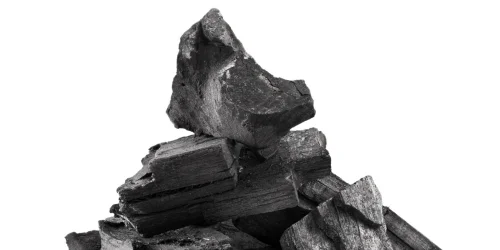
Another choice as a DIY dehumidifier to remove moisture from small spaces is a charcoal dehumidifier. You can make your charcoal dehumidifier at home to remove excess moisture content from a basement, closet, or attic. Making your charcoal dehumidifier is simple and takes very less time.
Things you need to make charcoal dehumidifiers
- Charcoal
- Large clean can with a lid
Procedure
- Punch holes into the sides of the can and on the lid as well.
- Place the charcoal inside the can with the holes poked in them. Cover the can with the lid.
- Keep this charcoal dehumidifier in a space that needs moisture extraction.
- The charcoal will begin to operate as a natural moisture absorber.
- You can simply replace the charcoal inside the can once every few months to keep the process going.
4. Non-dairy coffee creamer
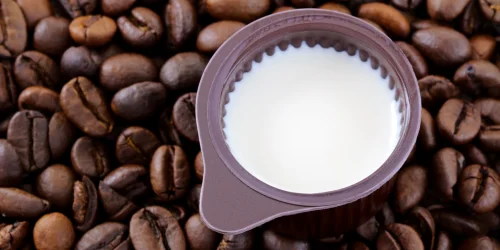
Another common household ingredient that can be used to absorb moisture is non-dairy coffee creamer or coffee whitener. If there is too much moisture in your closet or bathroom and you would prefer using a DIY dehumidifier to quickly get rid of the extra moisture coming in, you can rely on the coffee whitener homemade dehumidifier.
Things you need
- A medium-sized or large bowl.
- Coffee whitener or non-dairy coffee creamer
Procedure
- Fill the large bowl with the coffee whitener or non-dairy coffee creamer.
- Place the bowl in the area where the coffee whitener needs to absorb moisture.
- As the extra moisture is removed, the coffee whitener will turn hard.
- You can replace the bowl with another batch of coffee whitener or non-dairy coffee creamer to absorb moisture from the air.
5. Calcium chloride Dehumidifier
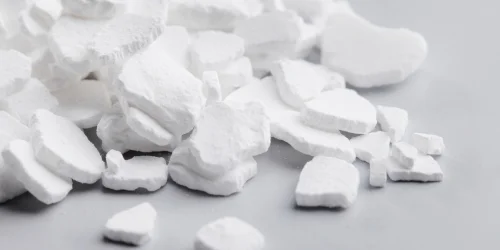
Another agent in the list of common household chemicals taht can be used to make a homemade dehumidifier is calcium chloride. Making your DIY calcium chloride dehumidifier is easy. You can make a DIY calcium chloride dehumidifier by using just a few items readily available at home. You must note that a calcium chloride homemade dehumidifier is fairly effective to cover large spaces and therefore can be used in a basement, attic, bathroom, kitchen, etc.
Things you need to make calcium chloride dehumidifier
- An old sock
- A piece of string.
- Calcium chloride
Procedure
- Fill calcium chloride inside the old sock.
- Secure the mouth of the sock tightly using a string.
- The calcium chloride inside the sock absorbs moisture from the surrounding.
- It can be replaced once in a few months or as required to continue the process.
6. Silica Gel Dehumidifier
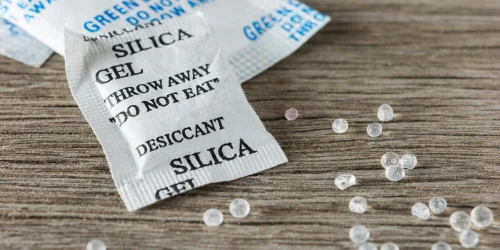
The last product that we have to make a homemade dehumidifier is silica gel beads. You cannot miss noticing silica gel beads in small packets that come along with packages that must be kept safe from moisture. Silica gel is a reliable moisture absorber that is often found in shoe boxes, any new container, gym bag, or any item that can quickly collect moisture. Using silica gel to make your homemade dehumidifier is possible. You can use a silica gel homemade dehumidifier as a moisture absorber for small spaces in your home.
Things you need to make a silica gel dehumidifier
- Silica gel
- A jar with a lid
- Screwdriver
Procedure
- Use the screwdriver to make holes inside the lid of the jar,
- Fill the jar with silica gel and seal it using the lid with the holes poked.
- Place this DIY dehumidifier with silica gel in the space that needs dehumidification.
- Silica gel is a trustworthy moisture absorber that can be replaced as required to continue the process.
Using a DIY dehumidifier: Tips and Tricks
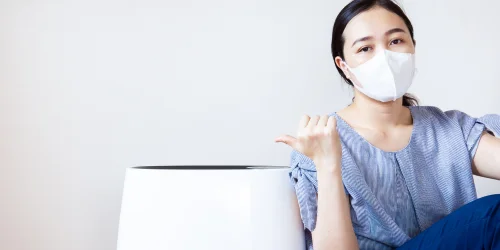
Although using a DIY dehumidifier is simple, here are some tips to help you:
- Choose a moisture absorber that you have easy access to or availability to.
- Install the bowl or can or bucket in a place that is out of reach from children and pets (since DIY dehumidifiers are not child-proof).
- Check on the material for refills.
- Install more than one DIY dehumidifier for larger spaces.
What is the fastest way to dehumidify a room?

The fastest way to dehumidify a room is by investing in a suitable dehumidifier unit. DIY dehumidifiers are not as effective as store-bought units. An electric dehumidifier is indeed a better choice to handle indoor humidity level fluctuations. Commercial dehumidifiers are equipped with several features that will make it efficient to dehumidify a room faster.
To carry out faster and quicker dehumidification you must first remove the source that leads to increased indoor humidity levels. Once the source of excess moisture is removed with a suitable moisture absorber or a dehumidifier, the process to balance the indoor humidity level to maintain the preferred relative humidity level becomes easier.
The difference between a DIY dehumidifier and a store-bought one
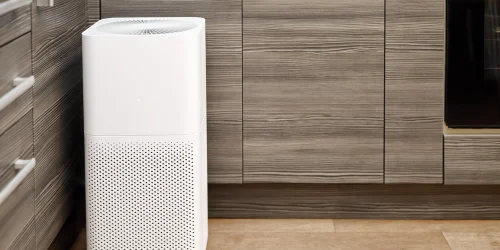
The differences present between a DIY dehumidifier and a store-bought one is many. Although the two carry out dehumidification, you will be able to notice differences in their performance and other factors. Let us discuss a few of them here.
Price
Without a doubt, store-bought units are expensive. To make your homemade dehumidifier you will only need things that are already available in your house. A large bag, rock salt or table salt, coffee whitener, etc., are easy to access and inexpensive as well. Units that you purchase from an online store or hardware store are certainly expensive.
Size
The size of a homemade dehumidifier is much smaller in comparison to the unit from the hardware store. If your home or room does not have any space to accommodate a unit, you can switch to a homemade moisture absorber that will fit within a large bowl.
Performance
Commercial or store-bought dehumidifiers are better performers. These units are built for this purpose and come packed with several advanced features to support dehumidification. An inbuilt humidistat to monitor indoor humidity, an Auto adjustable system to balance low humidity to ensure the desired relative humidity levels are maintained, Auto Shut Off and Restart, Full Tank indicators, Smart Modes, odor removal, etc., are just a few of the many benefits you get from a store-bought unit.
Although homemade dehumidifiers are effective, their impact is evident only within a small area. You cannot rely solely on their performance for areas that struggle with severe humidity troubles.
User-friendly
DIY units are very simple and straightforward to use. You will only need to refill the moisture absorber as and when required. They do not require any maintenance, apart from checking on the moisture absorber for refills.
Store-bought units are also user-friendly with simple control panels, but they require maintenance. The electrical outlet, facility to drain the water collected in the container, regular service, etc., are the aspects that need attention.
What is the best dehumidifier you can buy at a store?
hOmeLabs 50 Pint Dehumidifier
The best unit available in the market to assist the home in maintaining a deal of indoor humidity is the hOmeLabs 50 Pint Dehumidifier. This unit comes with a large capacity which is perfect for a large area. This hOmeLabs 50-Pint Dehumidifier can cover an area of up to 4,500 square feet, making it suitable for large living rooms, office spaces, basements, or an entire home.
The 50 pints of water which are extracted per day from the wet environment makes is collected in the 1.6-gallon removable water container or reservoir. The built-in wheels, sleek design, and compact size make it portable despite its large capacity.
The features that make this the best unit available in the market are; a 24-hour continuous cycle, Auto Shut Off, built-in compressor, continuous drainage, adjustable fan speed settings, and order removal. If you are looking for the ideal solution to remove stagnating moisture in the air, and keep away mold growth and musty odors, the hOmeLabs 50 Pint Dehumidifier is the best choice.
FAQ
1. What absorbs humidity naturally?
If you are looking for a natural moisture absorber, there are many options as aforementioned. Coffee whitener, calcium chloride, silica gel, etc., are good absorbers of excess moisture from the environment. The best natural moisture absorber however is rock salt. A DIY rock salt dehumidifier is an effective solution to keep moist air away.
2. Does opening windows reduce humidity?
Opening windows and improving air circulation will certainly help in reducing humid conditions. The air circulation between the indoor air and outdoor air will act in favor of bringing down the high humidity levels indoors.
3. Is 80% humidity high?
Yes. The comfortable and healthy humidity levels are between 30% to 60%. Anything above 60% is considered high humidity.
4. Why is my house humidity always high?
The reason for high indoor humidity is constant exposure to moisture. If your home is always humid, it could be majorly due to the climatic and weather conditions of the area. Apart from this, the moisture contributors can be leaks and indoor activities that contribute to humidity (washing, drying laundry indoors, cooking, steam baths).
Wrapping Up
That’s a wrap on the article. We hope you were able to learn the different options for making a DIY dehumidifier. Carefully evaluate the type that will meet your requirements to maintain healthy indoor humidity.

About The Author
Charles Allen is an enthusiast of HVAC/indoor air. He has been fascinated by the way HVAC systems work since he was a child. He enjoys learning about new technologies and finding ways to improve the efficiency of HVAC systems. He is always looking for new ways to help people save money on their energy bills.
